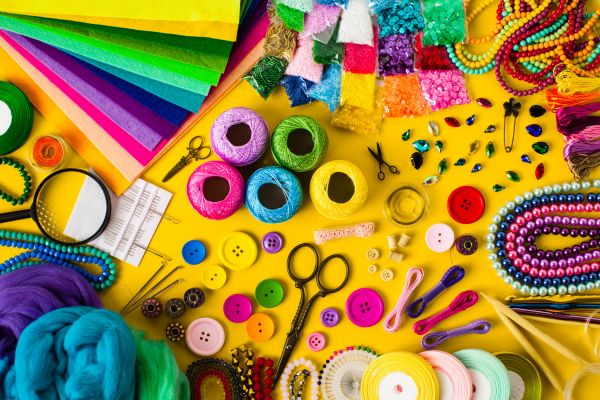DIY crafting is a popular and rewarding hobby that allows individuals to unleash their creativity and create unique handmade items. However, it’s not uncommon for crafters to encounter certain pitfalls along the way. In this article, we will explore five common mistakes in DIY crafting and provide practical tips on how to avoid them. By being aware of these mistakes and implementing preventive measures, you can enhance your crafting experience and achieve more successful and satisfying results in your projects.
1: Lack of Planning and Preparation
One of the most significant mistakes in DIY crafting is jumping into a project without proper planning and preparation. Failing to plan can lead to frustration, wasted time, and resources. Before starting a new project, take the time to research and gather all the necessary materials, tools, and instructions. Carefully read through the project guidelines and make a checklist of the required items. Planning ahead will help you anticipate any challenges, ensure you have everything you need, and streamline the crafting process.
Furthermore, it’s important to allocate enough time for your project. Rushing through a crafting endeavor can result in mistakes and subpar outcomes. Set aside dedicated crafting time in your schedule, allowing yourself the opportunity to focus and enjoy the process. By planning and preparing adequately, you’ll lay a solid foundation for a smoother and more successful crafting experience.
Additionally, consider creating a step-by-step plan or timeline for your project. Breaking it down into smaller tasks can help you stay organized and motivated. Determine the order in which you will tackle each step and estimate the time required for each task. Having a clear plan will minimize confusion, prevent unnecessary mistakes, and ensure that you stay on track throughout the project.
Lastly, don’t forget to create a comfortable and organized workspace. Arrange your tools, materials, and equipment in an easily accessible manner. Keeping a tidy and well-equipped space will save you time and frustration when searching for supplies. It will also help you maintain focus and productivity during your crafting sessions.
2: Ignoring Proper Technique and Skill Development
Another common mistake in DIY crafting is neglecting to learn and practice proper techniques. Each craft has its own set of skills and methods that contribute to successful results. Whether you’re knitting, sewing, painting, or engaging in any other craft, take the time to learn the fundamental techniques and practice them before embarking on more complex projects.
Start by mastering the basics and gradually build your skills. Beginner-friendly projects are excellent opportunities to hone your techniques and gain confidence. Familiarize yourself with the essential tools and understand how to use them correctly. Seek out tutorials, books, or online resources that provide guidance and instructions for learning proper technique in your chosen craft.
Additionally, consider joining craft communities or taking classes where you can learn from experienced crafters. Engaging with fellow enthusiasts will expose you to new ideas, techniques, and tips that can accelerate your skill development. Practice regularly and be patient with yourself. Crafting is a continuous learning process, and with time and dedication, you’ll see improvement and achieve higher quality results in your projects.
Moreover, challenge yourself by exploring advanced techniques and experimenting with different materials and styles. Pushing the boundaries of your skills will expand your creative horizons and keep your crafting experience exciting and engaging. Embrace the opportunity to learn and grow, and don’t shy away from trying new things in your crafting journey.
3: Neglecting Safety Measures
Safety should always be a top priority in DIY crafting. Ignoring safety measures can lead to accidents, injuries, or damage to your materials. It’s essential to familiarize yourself with the specific safety guidelines and precautions associated with your chosen craft. Whether it involves working with sharp tools, heat sources, or hazardous materials, understanding and implementing safety measures is crucial.
Start by reading the instruction manuals for your tools and equipment to understand their proper usage and safety features. Always wear appropriate safety gear, such as goggles, gloves, or aprons, when necessary. Follow instructions for proper ventilation and use protective measures like masks when dealing with fumes or dust. Remember to keep your workspace clean and organized, minimizing potential hazards.
If you’re working with chemicals or adhesives, ensure that you use them in well-ventilated areas and follow the manufacturer’s instructions carefully. Store potentially hazardous materials securely and out of reach of children or pets. By prioritizing safety, you can enjoy your crafting activities with peace of mind and avoid any unfortunate accidents.
Finally, if you’re uncertain about the safety aspects of a particular technique or material, seek guidance from experts or consult reliable resources. Craft forums, books, and online tutorials often provide valuable information and tips on how to handle specific safety concerns. Never underestimate the importance of protecting yourself and those around you while engaging in DIY crafting.
4: Poor Time and Project Management
Poor time and project management can lead to frustration and unfinished projects. It’s common to underestimate the time and effort required for a particular crafting project, resulting in rushed work or a lack of motivation to complete it. To avoid this mistake, break down your project into smaller, manageable tasks and estimate the time needed for each step.
Consider creating a project timeline or schedule that includes specific deadlines for each task. Be realistic in your time estimations, allowing for unexpected delays or challenges. Prioritize your tasks based on their importance and sequence, tackling the most critical steps first. By breaking down the project and managing your time effectively, you’ll maintain momentum and progress steadily towards the completion of your craft.
When managing your time, consider your other commitments and responsibilities to ensure a balanced approach. Avoid overloading yourself with too many projects simultaneously, as this can lead to burnout and diminished enthusiasm. By setting realistic expectations and managing your time wisely, you’ll enjoy a more fulfilling and less stressful crafting experience.
It’s important to acknowledge that crafting is a process that requires time and patience. Allow yourself the space to enjoy the journey and savor the creative process. Remember that crafting is meant to be a source of joy and relaxation, so avoid rushing through your projects and appreciate each step along the way.
5: Lack of Patience and Perseverance
Patience and perseverance are vital qualities for successful DIY crafting. It’s common to encounter challenges, setbacks, or mistakes during the crafting process. However, giving in to frustration or impatience can hinder your progress and diminish the joy of creating.
When faced with difficulties, take a step back, breathe, and approach the problem with a calm and patient mindset. Embrace mistakes as learning opportunities and be willing to try again or find alternative solutions. Crafting is a journey that requires time and effort, and not every project will turn out perfectly on the first attempt. With perseverance and a positive attitude, you’ll overcome obstacles and grow as a crafter.
It’s also essential to remember that crafting is subjective, and imperfections can add character and uniqueness to your creations. Embrace the beauty of handmade items and the fact that no two pieces will be exactly the same. Practice self-compassion and celebrate your progress, no matter how small. By cultivating patience and perseverance, you’ll find greater satisfaction and fulfillment in your DIY crafting endeavors.
Moreover, don’t hesitate to seek inspiration and support from the crafting community. Engage with other crafters, join online forums or social media groups, and share your experiences. Connecting with like-minded individuals who share your passion can provide encouragement, advice, and fresh perspectives. Celebrate each other’s successes and find motivation in the collective creativity of the crafting community.
Conclusion
Engaging in DIY crafting offers a world of creative possibilities and personal fulfillment. By avoiding common mistakes such as lack of planning, ignoring proper technique, neglecting safety measures, poor time management, and impatience, you can enhance your crafting experience and achieve better results in your projects. Remember to plan and prepare adequately, invest time in learning and practicing proper techniques, prioritize safety, manage your time effectively, and cultivate patience and perseverance. With these strategies in place, you’ll embark on a more rewarding and successful DIY crafting journey, creating beautiful and meaningful handmade items that reflect your unique style and creativity.



